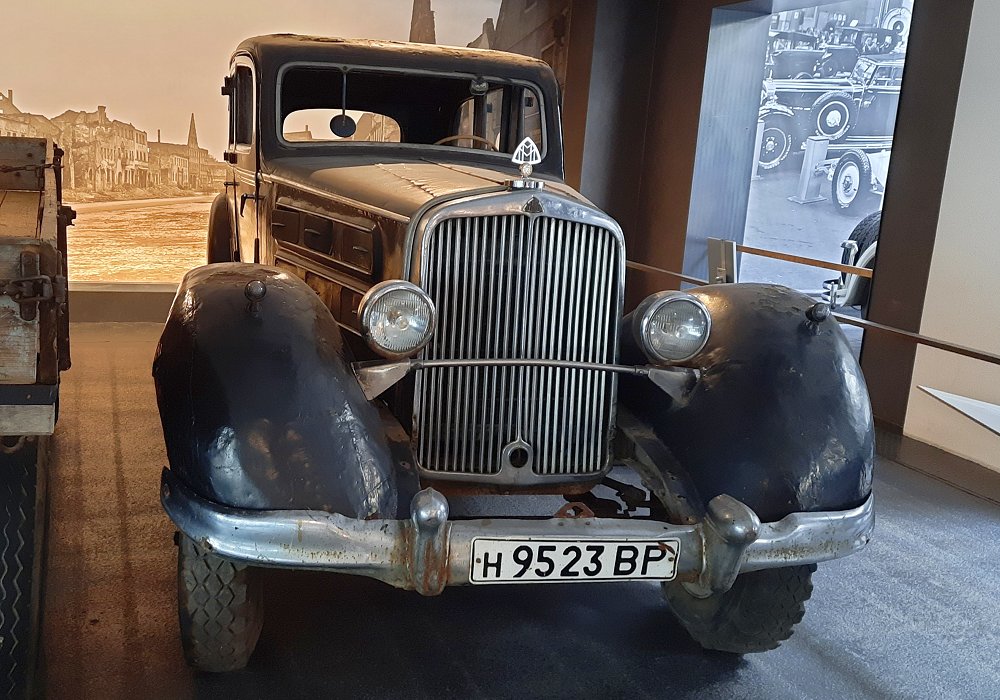Description
The Maybach DS 8 Zeppelin Pullman-Limousine by Spohn was one of the most imposing, luxurious and technically advanced automobiles built anywhere in the world during the early 1930s. As the ultimate expression of Maybach’s pre-war engineering and Spohn’s mastery of formal coachwork, it represented the absolute pinnacle of German prestige motoring. Reserved for heads of state, industrial magnates and the wealthiest private clients, it combined monumental scale, extraordinary mechanical refinement and handcrafted bespoke luxury in a manner unmatched even by most of its elite contemporaries.
The DS 8 Zeppelin chassis, introduced in 1931 as the successor to the already formidable DS 7, was built around Maybach’s most powerful engine. The enormous 8.0-litre V12 was one of the finest luxury powerplants of its era, producing around 200 horsepower — an exceptional figure for the time — and delivering immense torque with remarkable smoothness. Maybach’s background in aero-engine design gave the V12 an almost turbine-like character: quiet, perfectly balanced and capable of moving even the heaviest bodies with calm assurance. In the vast Pullman-Limousine configuration, this engine allowed the car to glide forward with effortless authority and maintain high cruising speeds in near-silence.
The chassis itself used a huge ladder-type steel frame engineered to provide absolute rigidity. Suspension was by long semi-elliptic leaf springs tuned for maximum comfort and stability, giving the car a dignified, floating ride even over the rough surfaces typical of early-1930s Europe. Steering was slow but steady, appropriate for a chauffeur-driven vehicle of this magnitude, and braking was provided by large mechanical drums offering strong performance for such a heavy luxury limousine. Although the DS 8 was not intended as a sporting machine, its long wheelbase and refined engineering made it extraordinarily composed at speed.
Maybach’s advanced dual-range gearbox gave the DS 8 a level of drivability far ahead of most contemporary luxury cars. With separate high and low ranges, the transmission allowed smooth progression in city traffic and effortless high-speed touring. This early form of multi-ratio flexibility reduced the workload on the chauffeur and contributed greatly to the limousine’s refined, uninterrupted motion.
It was Spohn’s coachwork, however, that gave the DS 8 Pullman-Limousine its unmistakable presence. Spohn of Ravensburg, Maybach’s preferred coachbuilder, was renowned for its mastery of formal bodies and hand-formed metalwork of exceptional quality. The Pullman-Limousine was the grandest body style offered on the DS 8 chassis. It featured an extended roofline, tall and expansive side windows, broad rear doors and elegant, flowing fenders. The proportions were majestic without being ostentatious, and the dignified stance conveyed authority from every angle. Each body was constructed entirely by hand, with every curve, joint and surface tailored precisely to the client’s requirements.
Inside, the DS 8 Zeppelin Pullman-Limousine Spohn reached a level of opulence rivalled only by the world’s most luxurious railway carriages and private yachts. The rear compartment was the car’s true centrepiece. Deep armchairs or a full-width bench were upholstered in the finest leather or hand-tailored cloth. Polished hardwood veneers, machined metal fittings, thick carpeting and delicately crafted cabinetry created an ambience of refined grandeur. Many examples were equipped with amenities such as fold-out writing desks, illuminated vanities, smoking sets, heater units, intercom systems, bespoke lighting arrangements and custom storage. A division window separated the passengers from the chauffeur, ensuring privacy and tranquillity.
On the road, the DS 8 Pullman-Limousine delivered a uniquely calm and stately driving experience. The V12 engine propelled the car with quiet strength, the suspension absorbed imperfections with remarkable grace, and the long wheelbase provided exceptional stability. Even at higher speeds, the car retained a serene composure that set it apart from nearly all other luxury vehicles of its time. For its elite owners, it symbolised power, dignity and supreme refinement.
Production of the DS 8 Zeppelin was extremely limited, and only a small number of chassis received Spohn Pullman-Limousine bodies. Each example was built to individual order, requiring months of specialised hand labour and commanding a price accessible only to an elite few. Surviving examples today are exceedingly rare and are considered among the most valuable and historically significant pre-war German automobiles.
The Maybach DS 8 Zeppelin Pullman-Limousine Spohn stands as one of the greatest achievements of early-20th-century automotive craftsmanship. It represents the peak of Maybach’s engineering prowess and Spohn’s unparalleled mastery of formal luxury coachwork. Regal, powerful and meticulously constructed, it remains one of the most impressive and awe-inspiring prestige cars ever built.



